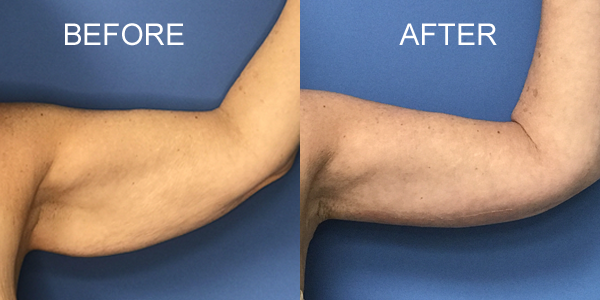INTRODUCTION
Underarm surgery or brachioplasty is more commonly known as an arm lift. This procedure tightens loose, sagging skin and removes excess fat deposits in the upper arm that develop with age or significant weight loss.

INDICATIONS
- excessive bleeding.
- permanent scarring.
- fluid buildup.
- nerve, muscle, or blood vessel damage.
- fatty tissue death.
PROCEDURE
Before the procedure
- Avoid certain medications. You’ll likely need to avoid taking aspirin, anti-inflammatory
drugs and herbal supplements, which can increase bleeding. - Arrange for help during recovery. Make plans for someone to drive you home after surgery
and stay with you as you begin to recover.
During the procedure
Your plastic surgeon will make incisions on the undersides of your arms. The length and
pattern of the incisions depends on how much skin will be removed.
After making the incisions, the plastic surgeon will tighten your underlying tissues and
secure them with stitches. He or she might also use a suction technique to remove fat
(liposuction).
Your skin will then be draped over the new contours and excess skin will be removed.
Stitches or surgical tape will be used to close the incisions.
After the procedure
After an arm lift, your incisions will be covered in bandages. Your arms will be loosely
wrapped in elastic bandages to minimize swelling. Small tubes might be placed in your arms
to drain any excess blood or fluid.
You’ll likely see someone from your plastic surgery team within a day or two after your arm
lift. He or she may remove your bandages and drainage tube if used. Some plastic surgeons
may have you wear a compression sleeve for a few weeks to keep swelling down
In the first few days after an arm lift:
- Avoid lifting your arms above shoulder level for three to four weeks.
- Avoid physical and athletic activities with your arms that might stretch the incisions for
four to eight weeks after surgery. - Take pain medication as needed and use topical or oral antibiotics as directed to
prevent wound infections.
Talk to your doctor about when — or if — your stitches will be removed. Some stitches
dissolve on their own. Others must be removed in the doctor’s office in the weeks after
the procedure.
After an arm lift, contact your doctor immediately if you have:
- Shortness of breath
- Chest pains
- An irregular heartbeat
- Redness of the skin and a fever
Results
By removing loose skin, an arm lift can give your upper arms a more toned
appearance.
Arm lift results are typically long lasting. Remember, however, your skin will naturally
lose some firmness as you age and some sagging might occur. Maintaining a stable,
healthy weight can help you retain your results.
FAQ
Q1 Is there surgery for flabby arms?
A1 Similarly, flabby arms can be corrected through a procedure known as
brachioplasty, or arm lift surgery. It is common to develop sagging, “bat-wing” arms as
we age or fluctuate in weight.
Q2 What is the best treatment for sagging arms?
A2 With no anaesthesia and no downtime, CoolSculpting is the ideal treatment to tone
your arms, targeting fat cells beneath the skin while leaving the skin itself unaffected.
The treated fat cells are crystallised (frozen), then die.
Q3 What is the recovery time for an arm lift?
A3 There is no universal timeline for recovery from an arm lift. Everybody heals at a
different rate based on factors such as skin health and overall health. However, in
general, the entire recovery process will take around two to three weeks.
